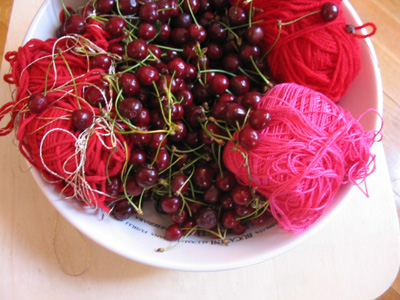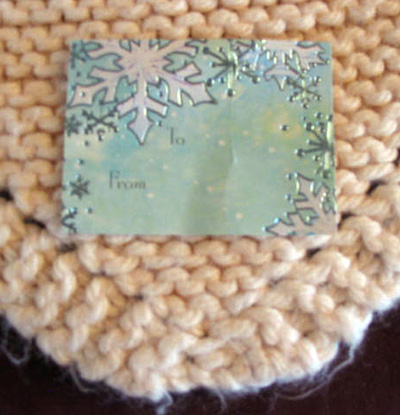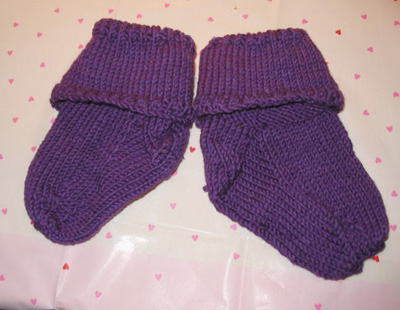  About
a year ago, I signed on as a test knitter
for a company. Taking on the challenge
of knitting something for pay - and that others
will see and emulate - is a very different
craft than knitting for yourself or loved ones. Things
that matter in my own knitting, like choice
of color and recipient, mean nothing in the
test knitting world. And things I can
overlook in my personal projects, like certain
techniques or gauge swatches (!), are essential
in sample knitting. This kind of knitting
teaches lessons all its own. About
a year ago, I signed on as a test knitter
for a company. Taking on the challenge
of knitting something for pay - and that others
will see and emulate - is a very different
craft than knitting for yourself or loved ones. Things
that matter in my own knitting, like choice
of color and recipient, mean nothing in the
test knitting world. And things I can
overlook in my personal projects, like certain
techniques or gauge swatches (!), are essential
in sample knitting. This kind of knitting
teaches lessons all its own.
Wouldn't you too like to
learn these lessons? What follows are the five
most important things I've learned from sample
knitting. I hope they can help you too,
even if you never test-knit a piece.
  1. Pay attention to the small stuff. 1. Pay attention to the small stuff.
How many times have we fudged a
technique because we didn't want to bother to look it up? Knitting
is as much about the process as the finished product, and yet how often
do we really focus on the process, each step of the way? I can't
tell you how many times I decided that the cable cast-on wasn't necessary,
just because I didn't want to learn something new just then. I
was anxious to get started, or only making a baby sweater after all,
or some other excuse. Finally, for a test project, I had to look
it up. And what do you know: it does make a difference after all! So
does the right way to pick up stitches, or to sew a shoulder seam. And
yet it was only because of my test knitting - because I was paid to do
a good job, the right job - that I cared enough to look up these techniques
and finally learn the right way to do them. It's the same principle as
when you clean your house for guests and you think, "Why don't I ever do this, just for myself?" Don't
we deserve clean houses to sit in, as well as entertain? Make your
knitting a clean house – take the time to do it the right way,
and see each piece as a chance to learn something new.
2. On the other hand, don't pay attention to ALL the small
stuff.
As a test knitter, you represent
to some extent the "every-knitter." You're not just creating
a solid product; you also come before lots of people who probably knit
just like you. This doesn't mean that you let mistakes slide, simply
because other people might make the same ones. But it does
mean that you have to learn to trust yourself. Once, I made a basic
sweater of my own design to test a potential new yarn for a company. My
knitting is pretty even, and yet this time from stitch to stitch it looked
shoddy and sloppy. Instead of pulling it all out, I continued with
as much care as I could muster, to make every stitch look straight. In
the end, the company didn't carry the yarn. Why? Because
it didn't knit up evenly, and displayed too many irregularities from
stitch to stitch. If I'd tried to vary my own style, I might have
misled the company into thinking the yarn was better than it really was. In
the end, the yarn or pattern is being tested - not the knitter. You
can only control so much, and that can really be a comfort sometimes.
  3. Don't get attached. 3. Don't get attached.
I wrote a piece
for Knitty a few
years ago about how knitted projects take on the personalities of their
intended recipients. But what happens when there is no intended
recipient? What do you think about, when you can't think of your
grandma or your boyfriend with every stitch? What’s more, you’re anonymous
too. The world will never know how you struggled with the sleeve
seams, or that you chose just the right color for your best friend’s
scarf. And what will happen to the piece? Will
it sit in the basement of some company headquarters, or will some stranger
be wearing it? Will they pull out your work, or maybe add a new
collar? You have to let these finished pieces go, and allow them
to land where they will. In the end, it's a good lesson in detachment
to knit without someone in mind, and without knowing what will happen
to the piece. Without you or the recipient in the picture, the
piece takes on a life of its own: you can see the personality of the
yarn, the pattern, and the creative whole, without complex feelings getting
in the way. It becomes about the knitting, not about the people
and emotions involved in it. And along the way you remember: you
love knitting. You love the process of knitting, not just
the people you’re knitting for. You just have to remember
that a piece of you is going into everything you make – even if
you don’t know where it will wind up. This has made it a
lot easier for me to part with knitted gifts: once the object leaves
my hands and goes into theirs, it’s theirs to do with what they
will. They might give it to the dog to lie on, instead of putting
it on their bed. But that doesn’t matter, because I didn’t
make it for just one reason. We have to learn to see each knitted
piece as the sum of its parts: yarn, needles, creativity, and US. Anything
more is icing.
  4. Knit things you normally wouldn't. 4. Knit things you normally wouldn't.
Ok, I'll admit
it. I don't like making
socks, I don't like knitting with alpaca, and I don't like ruffles. But,
although there's some choice in test knitting, we're not prima donnas
- we knit what we're assigned. I've had to do all these things
in the name of samples. And it's been really,
really good for me to step out of my fashion comfort zone. There's
something to be said for experiential knitting: taking on a project because
you want to know what makes it tick. Or using a yarn for no other
reason than that you want to know how it feels sliding through your fingers. You
can apply this to your own knitting: pick a friend who has a different
style than you, and ask him or her to help you choose your next project. Ask
your grandma, your spouse, your kids. Hell, ask a stranger on the
street. Take them to yarn shops; let them browse through your magazine
stash. Or, close your eyes and pick at random! No matter
how you do it, if you change your perspective, you'll be a better knitter
for it. And just because you don't like wearing certain things,
doesn't mean you won't like making them. You just might surprise
yourself.
5. You're only human - and so is everyone else.
I'd always looked upon the pictures
in knitting magazines and catalogs as the gold standard for how I should
knit. But knitted pieces aren’t prepared like gourmet recipes,
where you can never replicate the conditions and tools they use. No,
knitted samples are prepared by regular people like me – not Superknitters. We
use the same needles and the same tools that you do. We have the
same crazy cats grabbing at our stitches, and the same phones ringing
off the hook, just when we reach the all-important decrease rows. And,
designers make mistakes just like we do. If you can't figure out
a pattern - the numbers of stitches isn’t right, or your front
and back are mismatched - remember that it might not be you who's made
the error. Patterns can be wrong, and pictures can deceive. But
in the end, you can do it. Whatever you make from a pattern, remember
that at least one person has made it before you. And if we test
knitters can make it, so can you. So go ahead and try something
new - trusting your instincts from first stitch to last. You're
not alone! |

